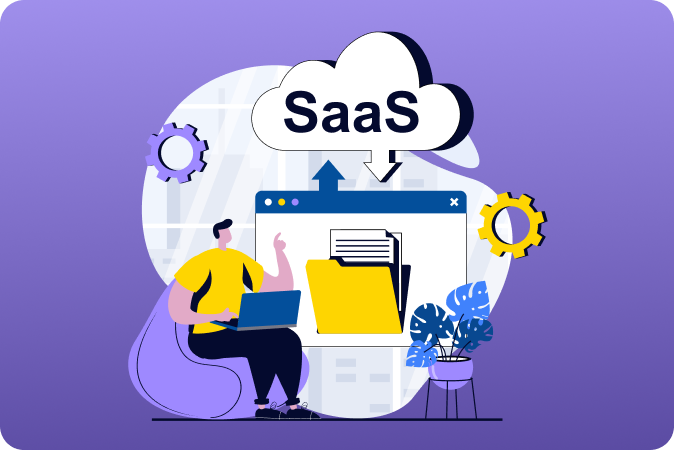
If you are wondering how to choose SaaS tools, here is the short answer. First, identify your needs. Then set a budget, check security, try the tool, compare options, plan for growth, and get your team on board. This SaaS buying guide will show you each step. You will see what to check, what to skip, and how to make the choice without wasting money. The SaaS market is massive. There are over 30,000 SaaS companies in the world. Almost half are based in the U.S. That means plenty of good tools, but also plenty of bad picks. The steps below will help you avoid them:
Step-by-Step Guide: What Is the Right Process for Choosing a SaaS Tool?
Choosing a SaaS tool is easier when you follow a clear process. Each step helps you filter out the wrong options and focus on solutions that truly fit your needs. So, let’s begin with the first step:
1. How Do I Identify My Needs Before Choosing a SaaS Tool?
Start by listing the exact problems you want to solve. This keeps you focused on tools that match your goals. Ask yourself:
- Which tasks are slow or error-prone?
- Who will use the tool daily?
- Is it for internal or customer-facing work?
| Task / Challenge | Current Method | Problem | Must-Have Feature |
| Lead tracking | Spreadsheet | Manual updates, errors | Automated CRM integration |
| Email marketing | Free tool | Limited scheduling | Advanced automation |
| Customer support tickets | Shared inbox | Lost follow-ups | Centralized ticket system |
2. How Do I Set a Realistic Budget for a SaaS Tool?
Look beyond the monthly price. Include onboarding fees, extra user costs, and paid add-ons. Here is a quick formula to see value: ROI = (Hours Saved x Hourly Rate) – Monthly Tool Cost If the tool saves 15 hours at $20/hour, you save $300. Even with a $100 monthly cost, you still gain $200. A $50/month tool that saves hours is better than a $10/month tool that does nothing.
3. Why Should I Check Security Features First?
Your SaaS tool must protect your data. Weak security risks breaches, fines, and loss of trust. Look for:
- Encryption in transit and at rest
- Two-factor authentication
- Regular backups
- Compliance like HIPAA, PCI DSS, or GDPR
If the provider cannot explain their security clearly, skip it. In 2023, a popular SaaS platform lost client data because they ignored server updates. Do not take that risk.
4. Why Should I Test SaaS Tools Before Buying?
Testing shows how the tool works with your real workflow. Do not rely on demo videos.
During the trial:
- Use your actual data
- Let the real users test it
- Check speed and mobile access
- Test key integrations
If it feels slow or confusing in the trial, it will not improve later.
5. How Can I Compare SaaS Tools the Smart Way?
Compare features side by side to see the winner clearly.
| Feature | Tool A | Tool B | Tool C |
| Price/month | $30 | $25 | $50 |
| Integrations | 5 apps | 15 apps | 20 apps |
| Security | Basic | Advanced | Advanced |
| Support | Chat + Email | 24/7 Phone | |
| Free trial | Yes | Yes | No |
Choose based on features, security, and usability—not just cost.
6. Should I Think About Scalability Now?
Yes. Your SaaS should grow with your business.
Ask these:
- Can it handle double my workload?
- Can I upgrade without moving data?
- Will the price still work when I grow?
Switching tools later is costly and time-consuming.
7. How Do I Get My Team to Use the New SaaS Tool?
Involve your team from the start. This increases adoption and reduces pushback. Steps:
- Let them try it during testing
- Provide simple training
- Show quick wins early
- Fix pain points fast
When your team feels included, they use the tool more willingly.
What Should You Check Before Buying a SaaS Tool?
A quick checklist can save you from picking the wrong tool. It works like a final filter before you commit. Things to check:
- Core features – Does it cover your must-have functions?
- Budget fit – Can you afford the monthly or yearly fee without stretching?
- Security – Does it meet industry standards like SOC 2 or ISO 27001?
- Ease of use – Can your team learn it in less than a week?
- Integration – Can it connect to your CRM, payment system, or email platform?
- Support – Will you get a reply within 24 hours if something goes wrong?
- Scalability – Will it still work if your users double or triple?
Pro tip:
Print this checklist and take it to every product demo. It keeps you focused on facts instead of hype. For businesses exploring SaaS solutions, platforms like WeekMate offer examples of integrated tools for task management, HR, and CRM. Studying these tools can help you understand common features, pricing models, and workflow integration options when evaluating your own SaaS choices.
How Can a SaaS Comparison Table Help You Choose?
| Feature | Tool A | Tool B | Tool C |
| Meets core needs | Yes | No | Yes |
| Pricing fit | $25/mo | $30/mo | $20/mo |
| Security compliance | SOC 2 | None | ISO 27001 |
| Ease of use | High | Medium | High |
| Integration options | 4+ apps | 2 apps | 5+ apps |
| Support quality | 24/7 chat | 24/7 chat | |
| Trial availability | 14 days | No trial | 7 days |
How to use it:
- Mark each point as Yes/No or give it a score out of 10.
- Highlight the tool that meets at least 80% of your critical needs.
- Never pick a tool with poor security or bad support — no matter how cheap it is.
What SaaS Buying Mistakes Should You Avoid?
Even the best tool can fail if it is the wrong fit for your business. Many companies lose time and money because of these mistakes:
Common mistakes:
- Choosing the cheapest option without checking features.
- Skipping the free trial and trusting online reviews blindly.
- Ignoring integration needs and ending up with a disconnected tool.
- Not asking the team who will use it daily.
- Overlooking security and compliance.
How to avoid them:
- Always run a short pilot test before buying.
- Ask for proof of security standards.
- Get feedback from real users before finalizing the deal.
Practical Example: How a Small Business Chose the Right SaaS Tool?
This example shows how a small Ecommerce store solved order management problems using a structured SaaS selection process. Orders were often delayed, and customer complaints were increasing.
What They Did: Step-by-Step
- Identify must-have features – inventory alerts, mobile access, and automatic invoice generation.
- Shortlist tools – selected four potential SaaS options from the market.
- Compare using a SaaS tool comparison table – rated each tool on features, pricing, and security.
- Run trials – tested the top two tools for 14 days each.
- Collect team feedback – three staff members gave input based on daily usage.
| Step | Action Taken | Outcome / Result | Key Lesson |
| 1 | Listed must-have features: inventory alerts, mobile access, automatic invoices | Focused on essential requirements | Always define core needs first |
| 2 | Shortlisted four SaaS tools | Narrowed options to manageable choices | Filtering early saves time |
| 3 | Used a SaaS tool comparison table (features, price, security) | Identified strengths and weaknesses of each tool | Compare systematically before deciding |
| 4 | Tested top two tools for 14 days | Experienced real workflow performance | Trial with real data prevents surprises |
| 5 | Collected feedback from three daily users | Team insights highlighted usability | Include users in the selection process |
Results Achieved
- Order errors dropped by 40% in the first month.
- Processing time per order decreased from 10 minutes to 6 minutes.
- Customer satisfaction improved by 15%.
- Key Takeaway: Following a clear, step-by-step process helps small businesses pick the right SaaS tool. It reduces mistakes and delivers measurable results quickly.
Wrapping Up
- If you want to know how to choose SaaS tools without regret, follow this SaaS buying guide step by step. Start by identifying your most urgent business needs. Set a clear budget. Check the security measures. Test the tool with real tasks. Compare shortlisted options. Plan for growth. Involve your team in every stage. This simple order helps you stay focused and avoid distractions. It ensures the tool works for your business today. It also prepares you for the demands of tomorrow. By following this process, you choose with confidence and avoid costly mistakes.
Start Choosing the Right SaaS Tool Today
Take control of your business workflows and efficiency by selecting the SaaS tool that truly fits your needs. Use the steps in this guide to make informed, confident decisions and avoid common mistakes.
FAQs
Q: How do I choose the best SaaS tool for my business?
Start by finding your biggest business challenge. Pick a SaaS tool that fixes this one problem well. Make sure it fits your budget. Check if it can grow with your business. Ignore extra features that you don’t need right now.
Q: Is there a SaaS buying guide for non-technical business owners?
Yes. Begin with tools that are easy to use. Your team should be able to work on it without training. Look for fast and friendly support. Check if the pricing is clear. Avoid tools that feel too complicated.
Q: How many SaaS tools do I need?
Only keep tools that do something unique. Remove anything that overlaps. Too many tools slow you down. They also waste money. A smaller tech stack is easier to manage and run.
Q: What is the first step in choosing a SaaS tool?
Know the exact problem you want to solve. Write it down before searching for options. This helps you focus on the right tools. You will save time and avoid wrong choices.



